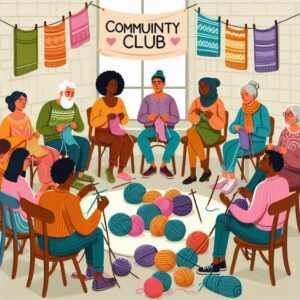Pet shelters are always in need of supplies to keep their furry residents comfortable and happy. When we think of donating, our minds might go straight to food, toys, or money. What often gets overlooked is how a simple knitted item can bring immense comfort to these animals. Whether it’s a cozy blanket or a snug sweater, knitted goods can make a world of difference.
Knitted blankets, for example, provide warmth and a sense of security to animals who might be scared or stressed in a new environment. It’s like giving them a piece of home. These blankets serve as a calming tool, helping pets adjust better and feel safer.
Imagine a tiny kitten clinging to a soft, knitted toy or a dog curling up on a plush blanket after a long day. These small gestures of love and care can significantly improve the well-being of these animals. Not to mention, they can brighten up the shelters and make them more inviting for potential adopters.
Hearing firsthand stories from shelters that have received knitted donations is enough to melt anyone’s heart. There’s the tale of Max, a senior dog who found comfort in a knitted blanket during his last days, or Luna, a kitten who wouldn’t sleep without her knitted toy. These stories show the real impact such donations can have.
So, if you’re looking for a meaningful way to help, consider picking up those knitting needles. A little time and effort spent on creating handmade items can lead to countless wagging tails and purring cats, proving that even yarn and needles can weave love and compassion into the lives of shelter animals.
How to Get Started: Knitting Essentials and Techniques
Getting started with knitting for pet shelters is easier than you might think. First off, you’ll need some basic materials and tools, including knitting needles, yarn, and a good pair of scissors. Most pet items can be made with simple, durable materials that won’t break the bank. Opt for machine-washable yarn that can withstand multiple washes, as pet items tend to get dirty.
For beginners, starting with straightforward patterns like small blankets or simple toys is ideal. These projects don’t require advanced techniques and can be completed relatively quickly. Pet blankets usually need only basic stitches like the garter or stockinette stitch. Simple knitted toys can be made by knitting small squares or rectangles and then stuffing them with soft filling.
A step-by-step guide can be very helpful when you’re new to knitting. Start with casting on, which is the process of creating the initial stitches on the needle. From there, learn basic stitches like the knit stitch and purl stitch. These foundational stitches can be combined to create various textures and patterns.
Don’t worry if it feels challenging at first. Knitting is one of those skills that gets easier with practice. There are plenty of online resources, video tutorials, and even local knitting groups where you can get tips and advice from experienced knitters. Joining a knitting community can also add a social element to your new hobby, making it even more enjoyable.
As you gain confidence, you can move on to more complex patterns like pet sweaters. These projects often involve additional techniques such as increasing and decreasing stitches. Again, online tutorials can be invaluable, guiding you through each step.
Remember, the goal is to create items that will bring comfort and joy to pets in shelters. Each stitch you make, no matter how simple, contributes to a bigger cause. Happy knitting!
Beyond the Yarn: Building a Community of Care

Knitting for pet shelters doesn’t have to be a solo mission. Organizing knitting groups can amplify your efforts and create a sense of community around this heartfelt cause. Local libraries, community centers, and even coffee shops can serve as meeting spots for weekly or monthly knit-togethers. These gatherings can foster new friendships and create a network of support for your shared goal.
Collaborating with local shelters and rescue organizations is another excellent way to make a significant impact. Reach out to these groups to find out their specific needs and preferences. Some might prioritize blankets, while others may need sweaters or toys. Building a relationship with them ensures that your knitted items are used where they’re most needed. It’s also a great opportunity to learn more about the animals you’re helping and the challenges shelters face.
Social media can be a powerful tool for spreading the word and encouraging others to join in. Sharing your knitting projects online, documenting your progress, and showcasing the finished products can inspire friends and followers to take up knitting for shelters. Creating a hashtag for your cause can help build an online community and keep everyone connected.
Community outreach events can further expand your efforts. Host a knitting workshop at a local fair, or set up a booth at a pet adoption event to attract more volunteers. These activities not only raise awareness but also bring in more hands to help with knitting projects.
Advocacy is another essential aspect of this mission. Educate others about the benefits of knitted donations and how they improve the lives of shelter animals. The more people understand, the more likely they are to contribute. Encourage schools, clubs, and workplaces to host their own knitting drives.


This is such a heartwarming initiative! The idea of knitting for pet shelters is truly inspiring and highlights how something as simple as a handmade item can make a huge difference in the lives of shelter animals. It’s amazing to think that a cozy blanket or a knitted toy can provide comfort and a sense of security to pets who may be feeling scared or stressed in a new environment.
From my experience, knitting for shelters has been incredibly fulfilling. I’ve made everything from small blankets to toys, and seeing how much joy these items bring to the animals is priceless. It’s also a wonderful way to use a skill for a great cause and connect with others who share the same passion.
I’m curious though, do you have any tips or advice for organizing a large-scale knitting drive or collaborating with multiple shelters? It would be great to know how to effectively coordinate efforts and ensure that the items are distributed where they’re needed most.
Thank you so much for your thoughtful comment and for sharing your own experience knitting for shelters—it’s truly inspiring to hear how fulfilling it has been for you! Organizing a large-scale knitting drive can indeed amplify the impact, and collaboration is key. To start, I’d recommend reaching out to local shelters to understand their specific needs, as some may require more blankets while others might need toys or other items.
Creating a central platform, either through social media or a community group, can help coordinate volunteers and track progress. Alternatively, if you have friends who knit, you can gather to knit together. There are also knitting groups on social media if you prefer to connect virtually. Additionally, consider reaching out to local yarn stores about organizing a knitting event or similar activities. Setting clear goals, like a target number of items or specific deadlines, can keep everyone motivated and focused. Finally, when it comes to distribution, working with shelter coordinators to identify where the greatest need is will ensure that the items are used where they can make the most difference. It’s wonderful to see so many people coming together for such a meaningful cause!